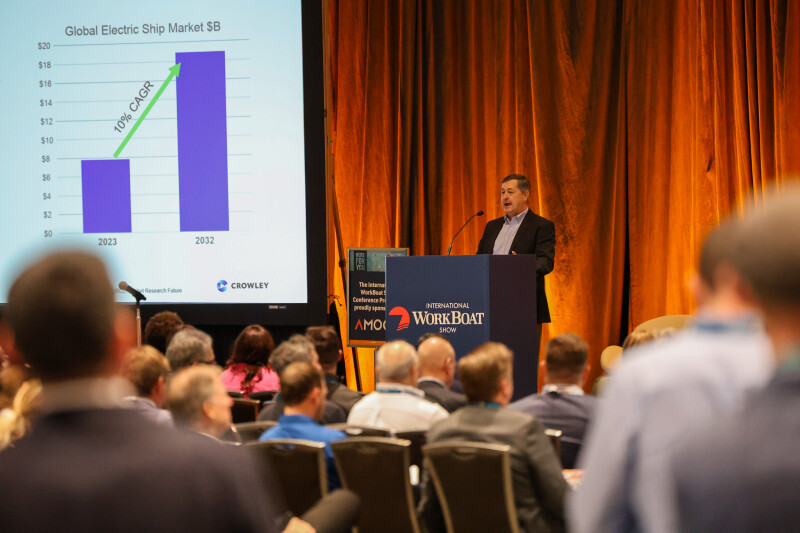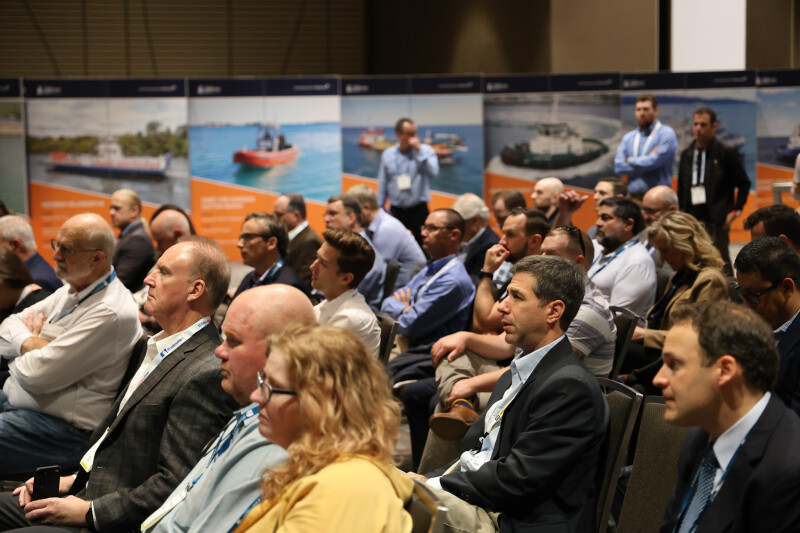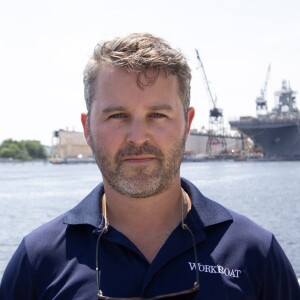In the opening conference session at the 43rd International WorkBoat Show Wednesday on marine electrification, Baskar Vairamohan, session moderator and electrification program manager at EPRI (Electric Power Research Institute), said his company felt "that this topic is very active."
“They’re (the federal government) pouring a lot of money into ports. The question is, how do you make sure all of that money goes to the right places?” Matt Jackson, vice president of advanced energy at Crowley Maritime, asked.
He noted the Infrastructure Investment and Jobs Act that’s invested more than $17 billion in port infrastructure. “The Inflation Reduction Act includes $3 billion for port electrification and efficiency, and in America alone, you can see it’s going to be a $1.4 billion dollar market right now,” Jackson said.

Jackson discussed Crowley’s E-Wolf, the first Jones Act-compliant, all-electric powered harbor tugboat in the U.S. that is expected to go into operation at the Port of San Diego next year. The tug is expected to have full performance capabilities and zero carbon emissions, replacing tugs that consume more than 30,000 gals. of diesel per year.
Marcelino Alvarez, CEO of Photon Marine, discussed what he’s seeing in the electric outboard arena. “The future of maritime electrification starts with workboats. When we talk about commercial, we’re looking at applications in tourism, transportation, mariculture, and ports and utilities,” he said.
Alvarez provided a utility customer example using Photon’s P300 prototype. Using Photon’s P300 electric outboard to travel 29.2 miles, the motor would use 62.6-kWh battery pack. At 34 cents a mile, the total cost of that transit would amount to $10.02. “For comparison, you might spend four-to-five times that amount using a gas engine,” Alvarez said.
Over the engine’s lifecycle, the break even point between the cost of an electric vs. the cost of a gas outboard is two-and-a-half years, though that varies based on use cases. “We’ve seen instances where the payback period is closer to 14 months, and some cases where it’s closer to five years,” Alvarez said.
The key drivers for the shift to electric include efficiency, emission regulations, sustainability goals, easy maintenance, and grant funding. Major challenges include cost, technology, supply chain limitations, and regulations.
Randy Fenton, marine infrastructure manager at New York Power Authority Canals (NYPAC), provided a different outlook on electrifying the waterways. “We’re just testing the waters on the electric side of the industry. It’s a difficult one to enter into. Our goal at the power authority, as mandated by our state for our light-duty vehicles, is that by 2025 we need to be 50% electric.”

Earlier this year, Fenton was the only one at NYPAC looking into electrification and called on one of NYPAC's industry partners, Silverback Marine, who was in the beginning stages of partnering with Photon Marine.
He flew from Buffalo, N.Y., to Miami to witness the engine’s performance firsthand. “From there, it took off like a rocket,” he said. “We ended up setting up a week-long pilot program to bring this vessel into our waters. It’s a very calm waterway, making it a controlled pilot program. What was nice is we had a brand new 21-foot workboat with a combustion engine, and another new 21-foot workboat with a Photon electric propulsion on it to do a side-by-side comparison. We let our crews handle these boats, they weren’t run Photon or the commercial engine company, we said, ‘Use it like you would a normal boat’ and they did,” said Fenton, emphasizing the lack of bias in their data.





